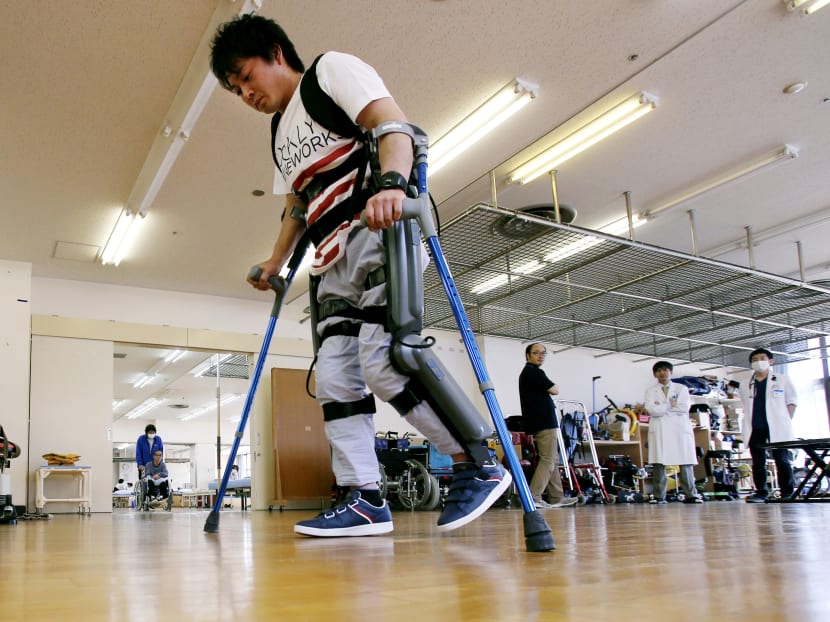Can robots make up for Japan’s care home shortfall?
TOKYO — The machines that make it on to the evening news bulletins are, unsurprisingly, the eye-catchers: exoskeletons, internet-of-things gizmos, humanoid or animal-shaped robots. Their dual purpose, at this point, is not just to serve the elderly but to convince the Japanese public as a whole that the nation has what it takes to fight its growing demographic crisis with technology.

Mr Yuichi Imahata walks using a robotic exoskeleton called ReWalk at Kanagawa Rehabilitation Centre in Atgugi, west of Tokyo. Every few months, Japan introduces the latest robot for its growing network of nursing homes. Photo: AP
TOKYO — The machines that make it on to the evening news bulletins are, unsurprisingly, the eye-catchers: exoskeletons, internet-of-things gizmos, humanoid or animal-shaped robots. Their dual purpose, at this point, is not just to serve the elderly but to convince the Japanese public as a whole that the nation has what it takes to fight its growing demographic crisis with technology.
A quarter of Japan’s population is already over 65 and the working-age population is shrinking at a rate of 1 per cent a year. The government’s estimate is that the country will need 2.5 million skilled care workers by 2025 but will experience a shortfall of 380,000.
That calculation has always looked grim as long as policies that would allow mass immigration remain off the table, which they do. Even as Japan prepares to vote in a general election, neither the ruling nor main opposition party is eager for a debate on that subject.
The early footsoldiers in the bid to automate nursing homes are machines such as Chapit, which looks like a mouse, sits at a person’s bedside and engages in a rudimentary chat; Robear, which looks like a bear and can lift a person off their bed and into a wheelchair; and Palro, a small humanoid that can lead a room full of elderly people in an exercise routine, occasionally breaking the boredom by setting quizzes.
These advances and many like them are good but gimmicky, say government officials. A paper on nursing care robots by the Ministry of Health, Labour and Welfare says that deeper work is needed on machinery and software that can either replace human care workers or increase staff efficiency.
In all cases, the challenge is not simply producing the idea — such as shoes that track their elderly users or robotic walking assistants that can “read” the road — but producing them at a viable price.
Ms Yukio Honda, director of the Robotics and Design Centre at the Osaka Institute of Technology, thinks robots will change, not eliminate, nurses’ roles. “Nurses will be freed from heavy work . . . Robots will do the (hard, dirty and dangerous) jobs and nurses’ roles will be to give them instructions.”
A spokesperson for Panasonic, which has produced an exoskeleton to aid in lifting objects, says robots can “lessen the burden of nursing care workers”.
“However, when we consider factors such as maintaining the quality of services . . . we think that these solutions are not enough to offset the shortage (of human carers).”
In the case of artificial intelligence, the business of nursing care has put Japan ahead in some surprising areas. An entire line of research at Kyoto-based NTT Communication Science Laboratories is focused on improving the quality of conversation of “communication robots” so that they are capable of arguing a point and know how to deploy stored knowledge in a debate.
The lack of human solutions to the ageing population, say analysts, may help explain the early eagerness of Mr Shinzo Abe to divert government funding towards developing nursing care robots and promoting their use.
Soon after he became prime minister in 2012, he earmarked ¥2.39 billion (S$28.6 million for that purpose and set the Ministry for Economy, Trade and Industry the task of finding 24 companies that would receive subsidies for their work on nursing care robots.
Ideas already under way include self-driving toilets that contain an internal flushing mechanism and could move around nursing homes meeting demand as it arises.
Other researchers are focused on the kind of sensors and AI software that could be added to mattresses to provide a single control centre with real-time information on residents.
Nursing care service provider Sompo Care Next has for the past year been experimenting with DFree, a device that can sense and predict when residents need the toilet, saving dozens of unnecessary nurse visits to patients every day.
When it comes to the technologies that will allow small numbers of nurses to deal with large populations of elderly people, says a government analyst, Japan has the double advantage of both a pressing need and the skilled engineers to produce solutions.
As well as presenting Japanese technology companies with a lucrative domestic nursing-home market for their innovations, the potential for exports is huge. The United Nations estimates that China will have a population of about 200 million over-65s by the year 2025 and a report by the Daiwa Institute of Research suggests the Chinese market for robots and other elderly care goods could hit RMB107 trillion (S$21.9 trillion)by 2050. FINANCIAL TIMES






